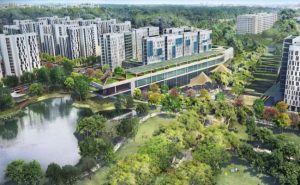A recent report by OCBC said that as its media business in FY19 was a drag on results, and with a weak macro backdrop likely to continue to weigh on its advertisement revenue moving forward, it is relying more on property for income diversification.
The report noted that SPH has made some strides in media business with its digital push and income diversification strategy, as shown by its latest acquisition of UK student accommodation assets, but its Singapore residential property exposure in Bidadari still remains a source of potential headwind.
In its investment summary OCBC said:
“Under expectations – SPH’s FY19 results came in below our expectations. The group’s operating revenue was down 2.4% YoY to S$959.3m, bolstered by revenue contribution from its Purpose-Built Student Accommodation (PBSA) portfolio, SPH REIT’s Figtree Grove and Rail Mall, which helped to offset declines in its media revenue.
The group’s newspaper ad revenue YoY decline has increased from 12.4% in FY18 to 13.9% in FY19, owing to notable weakness in the Classified segment. PATMI was down 23.4% YoY to S$213.2m, due largely to the lack of investment income, following the previous divestment of the group’s Treasury & Investment portfolio. Adjusting for exceptional and one-off items, core PATMI came in at S$155.2m, comprising 96.5% of our full-year forecast. The group has declared a final and special DPS of 5.5 S-cents and 1S-cents, bringing the full-year DPS to 12 S-cents.
Relying on property moving forward – SPH has also announced that it will be looking to streamline its media sales capabilities, with around 5% reduction in staff numbers across the Media Group. We expect modest net cost savings in FY20, given that the group will be incurring ~S$8m in retrenchment cost in 1QFY20. Moving forward, we believe the group will continue to be on the lookout for more PBSA assets, building on its portfolio AUM of more than S$600m though we note that cap rates for such assets in the UK have been compressing.
The group has also partnered a Japanese asset manager to set up a fund focusing on aged care and healthcare assets in Japan; SPH will be contributing up to S$50m in seed equity. Separately, we note that Woodleigh Residences is 20% sold as at 31 Aug, with an ASP of ~S$1.9k psf. In our view, the group’s media business outlook remains challenging, and we believe it is still too early to call the bottom on this segment. We roll forward our valuations and reduce our FV slightly from S$2.29 to S$2.28.”
The OCBC report mirrors that of CGS-CIMB report released in April, CGS-CIMB said that they were negatively surprised by the year-on-year decline in media business revenue at SPH, and that Singapore Press Holdings is now anchored by property.
Table of Contents
The finance company pointed out that “SPH reported 2Q19 core PATMI of S$28.7m, which fell 29% yoy, mainly due to lower media topline (print ad sales -S$14.1m, circulation revenue -S$3.2m) and absence of investment income.”
It added that the Singapore Press Holding’s media business is still not a pretty sight.
“While 2Q is a seasonally weaker quarter, we were negatively surprised by the 13.8% yoy decline in media revenue (1Q19: -6.8% yoy), possibly reflecting some frontloading of sales in the prior quarter. Digital newspaper circulation grew 12% yoy to 23k copies and digital ad revenue rose 6.7% yoy in 1H19, but we think these digital initiatives would take more time before offsetting the revenue shortfall in the print business. The 12.9% yoy reduction in staff costs was unable to mitigate the 31.7% surge in average newsprint charge-out price, resulting in 2Q19 PBT margin of 7.3% (2Q18: 9.8%, 1Q19: 19.9%).”
 While that being the case for SPH’s media business, their property segment is growing from strength to strength said the CGS-CIMB report released on 9 April.
While that being the case for SPH’s media business, their property segment is growing from strength to strength said the CGS-CIMB report released on 9 April.
“The property segment now forms 2/3 of SPH’s profits and delivered higher steady income stream from the recent acquisitions of SPH Reit (69%-owned subsidiary), Figtree Grove in Australia and the Rail Mall. SPH has also expanded its UK student accommodation portfolio to S$369m with two smaller assets in Lincoln and Glasgow; we expect more sizeable ones in the pipeline. The residential component of Woodleigh Residences is scheduled for official sales launch by May 2019.”
CGS-CIMB said that besides property, that SPH’s growth plan include digital transformation, aged care business.
“With the completed privatisation of M1 (and increased stake to 16.1%), we now project higher associates’ contribution for SPH, but think that any major digital transformation will be spearheaded by Keppel. Bed occupancy rate at its aged care operations remains healthy in the range of 80%, with possible expansion opportunities, both at home and overseas. We think execution is key to watch.”
Following CGS-CIMB’s report that Singapore Press Holdings is now being anchored by property, Singapore Press Holdings Limited announced that it will acquire a portfolio of Purpose-Built Student Accommodation in the United Kingdom.
https://www.icompareloan.com/resources/woodleigh-residences/
SPH’s wholly-owned subsidiaries, Straits Five Pte. Ltd, Straits Six Pte. Ltd. and Straits Eight Pte. Ltd. entered into a sale and purchase agreement with Habitus Holdings S.À R.L., Privilege Holdings S.À R.L. , Privilege Southampton Holdings S.À R.L. and AIGGRE Europe Real Estate Fund I GP S.À R.L to acquire a portfolio of Purpose-Built Student Accommodation (PBSA) assets in the UK for a cash consideration of approximately £133.7 million (approximately S$237.0 million).
The portfolio spans 3 cities in the UK and has a total capacity of 1,243 beds. They are situated in Southampton, Sheffield and Leeds, which have sizeable full-time student populations and enjoy strong occupancy rates in excess of 90.0%. The portfolio comes with a rental guarantee that covers the 2018/2019 and 2019/2020 academic years. This provides earnings visibility as SPH integrates the assets into its current portfolio of PBSA managed assets.
Adding to the recent acquisition of 380 beds in Lincoln and Glasgow, SPH’s PBSA portfolio has a total capacity of over 5,000 beds across 20 assets in 10 cities. The AUM is now in excess of S$600 million, establishing SPH as a leading PBSA player in the UK.
With an enlarged platform, SPH can extract greater economies of scale and has started operationalising its asset management capabilities under the new Capitol Students brand.
Singapore Press Holdings has developed on-ground operational expertise, with a dedicated team of 5 in the UK, 8 in Singapore overseeing the portfolio together with more than 100 employees managing the assets.
https://www.icompareloan.com/resources/uk-student-accommodation/
Sales and marketing capabilities have also been expanded, with a centralised marketing and sales office. A community portal is also being developed for the 2019/2020 academic year, supported with backend business processes and booking systems. The portal is envisaged to define the students’ experience and be the connection through which Capitol Students partners the institutions and parents on the students’ lifeshaping campus journey.
The world class higher education system in the UK is well-placed to grow, backed by rising demand from both local and international students. With a healthy student-tobed ratio, the asset class has demonstrated strong rental growth over the years.
Mr Ng Yat Chung, Chief Executive Officer of Singapore Press Holdings, said: “Since our first PBSA investment in September 2018, we have now successfully completed four acquisitions in the UK. These acquisitions are high quality, cash-yielding assets in key student cities in the UK and will enhance our recurring income going forward. We remain disciplined in our acquisition pipeline, to build our UK PBSA portfolio to a platform of scale.”
This transaction was completed on 16 April 2019.






